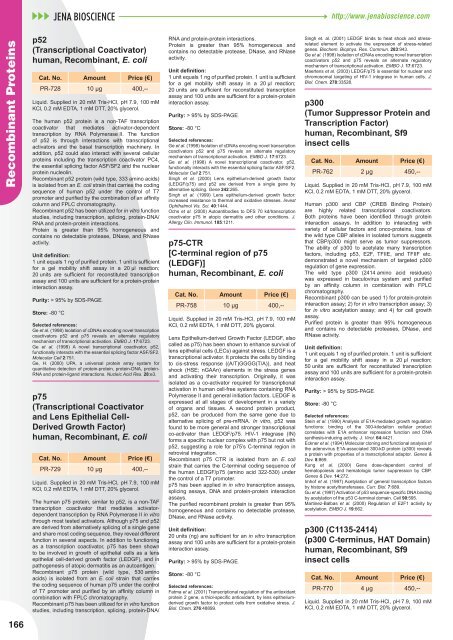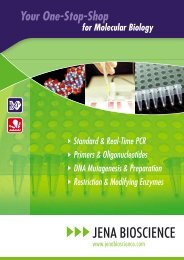Nucleotide Analogs - Jena Bioscience
Nucleotide Analogs - Jena Bioscience
Nucleotide Analogs - Jena Bioscience
You also want an ePaper? Increase the reach of your titles
YUMPU automatically turns print PDFs into web optimized ePapers that Google loves.
Recombinant Proteins<br />
166<br />
p52<br />
(Transcriptional Coactivator)<br />
human, Recombinant, E. coli<br />
Cat. No. Amount Price (€)<br />
PR-728 10 µg 400,--<br />
Liquid. Supplied in 20 mM Tris-HCl, pH 7.9, 100 mM<br />
KCl, 0.2 mM EDTA, 1 mM DTT, 20% glycerol.<br />
The human p52 protein is a non-TAF transcription<br />
coactivator that mediates activator-dependent<br />
transcription by RNA Polymerase II. The function<br />
of p52 is through interactions with transcriptional<br />
activators and the basal transcription machinery. In<br />
addition, p52 could also interact with several cellular<br />
proteins including the transcription coactivator PC4,<br />
the essential splicing factor ASF/SF2 and the nuclear<br />
protein nucleolin.<br />
Recombinant p52 protein (wild type, 333 amino acids)<br />
is isolated from an E. coli strain that carries the coding<br />
sequence of human p52 under the control of T7<br />
promoter and purifi ed by the combination of an affi nity<br />
column and FPLC chromatography.<br />
Recombinant p52 has been utilized for in vitro function<br />
studies, including transcription, splicing, protein-DNA/<br />
RNA and protein-protein interactions.<br />
Protein is greater than 95% homogeneous and<br />
contains no detectable protease, DNase, and RNase<br />
activity.<br />
Unit defi nition:<br />
1 unit equals 1 ng of purifi ed protein. 1 unit is suffi cient<br />
for a gel mobility shift assay in a 20 µl reaction;<br />
20 units are suffi cient for reconstituted transcription<br />
assay and 100 units are suffi cient for a protein-protein<br />
interaction assay.<br />
Purity: > 95% by SDS-PAGE.<br />
Store: -80 °C<br />
Selected references:<br />
Ge et al. (1998) Isolation of cDNAs encoding novel transcription<br />
coactivators p52 and p75 reveals an alternate regulatory<br />
mechanism of transcriptional activation. EMBO J. 17:6723.<br />
Ge et al. (1998) A novel transcriptional coactivator, p52,<br />
functionally interacts with the essential splicing factor ASF/SF2.<br />
Molecular Cell 2:751.<br />
Ge, H. (2000) UPA, a universal protein array system for<br />
quantitative detection of protein-protein, protein-DNA, protein-<br />
RNA and protein-ligand interactions. Nucleic Acid Res. 28:e3.<br />
p75<br />
(Transcriptional Coactivator<br />
and Lens Epithelial Cell-<br />
Derived Growth Factor)<br />
human, Recombinant, E. coli<br />
Cat. No. Amount Price (€)<br />
PR-729 10 µg 400,--<br />
Liquid. Supplied in 20 mM Tris-HCl, pH 7.9, 100 mM<br />
KCl, 0.2 mM EDTA, 1 mM DTT, 20% glycerol.<br />
The human p75 protein, similar to p52, is a non-TAF<br />
transcription coactivator that mediates activatordependent<br />
transcription by RNA Polymerase II in vitro<br />
through most tested activators. Although p75 and p52<br />
are derived from alternatively splicing of a single gene<br />
and share most coding sequence, they reveal different<br />
function in several aspects. In addition to functioning<br />
as a transcription coactivator, p75 has been shown<br />
to be involved in growth of epithelial cells as a lens<br />
epithelial cell-derived growth factor (LEDGF), and in<br />
pathogenesis of atopic dermatitis as an autoantigen.<br />
Recombinant p75 protein (wild type, 530 amino<br />
acids) is isolated from an E. coli strain that carries<br />
the coding sequence of human p75 under the control<br />
of T7 promoter and purifi ed by an affi nity column in<br />
combination with FPLC chromatography.<br />
Recombinant p75 has been utilized for in vitro function<br />
studies, including transcription, splicing, protein-DNA/<br />
RNA and protein-protein interactions.<br />
Protein is greater than 95% homogeneous and<br />
contains no detectable protease, DNase, and RNase<br />
activity.<br />
Unit defi nition:<br />
1 unit equals 1 ng of purifi ed protein. 1 unit is suffi cient<br />
for a gel mobility shift assay in a 20 µl reaction;<br />
20 units are suffi cient for reconstituted transcription<br />
assay and 100 units are suffi cient for a protein-protein<br />
interaction assay.<br />
Purity: > 95% by SDS-PAGE.<br />
Store: -80 °C<br />
Selected references:<br />
Ge et al. (1998) Isolation of cDNAs encoding novel transcription<br />
coactivators p52 and p75 reveals an alternate regulatory<br />
mechanism of transcriptional activation. EMBO J. 17:6723.<br />
Ge et al. (1998) A novel transcriptional coactivator, p52,<br />
functionally interacts with the essential splicing factor ASF/SF2.<br />
Molecular Cell 2:751.<br />
Singh et al. (2000) Lens epithelium-derived growth factor<br />
(LEDGF/p75) and p52 are derived from a single gene by<br />
alternative splicing. Gene 242:265.<br />
Singh et al. (1999) Lens epithelium-derived growth factor:<br />
increased resistance to thermal and oxidative stresses. Invest<br />
Ophthalmol Vis. Sci. 40:1444.<br />
Ochs et al. (2000) Autoantibodies to DFS 70 kd/transcription<br />
coactivator p75 in atopic dermatitis and other conditions. J.<br />
Allergy Clin. Immunol. 105:1211.<br />
p75-CTR<br />
[C-terminal region of p75<br />
(LEDGF)]<br />
human, Recombinant, E. coli<br />
Cat. No. Amount Price (€)<br />
PR-758 10 µg 400,--<br />
Liquid. Supplied in 20 mM Tris-HCl, pH 7.9, 100 mM<br />
KCl, 0.2 mM EDTA, 1 mM DTT, 20% glycerol.<br />
Lens Epithelium-derived Growth Factor (LEDGF, also<br />
called as p75) has been shown to enhance survival of<br />
lens epithelial cells (LECs) against stress. LEDGF is a<br />
transcriptional activator. It protects the cells by binding<br />
to cis-stress response ((A/T)GGGG(T/A)), and heat<br />
shock (HSE; nGAAn) elements in the stress genes<br />
and activating their transcription. Originally, it was<br />
isolated as a co-activator required for transcriptional<br />
activation in human cell-free systems containing RNA<br />
Polymerase II and general initiation factors. LEDGF is<br />
expressed at all stages of development in a variety<br />
of organs and tissues. A second protein product,<br />
p52, can be produced from the same gene due to<br />
alternative splicing of pre-mRNA. In vitro, p52 was<br />
found to be more general and stronger transcriptional<br />
co-activator than LEDGF/p75. HIV-1 integrase (IN)<br />
forms a specifi c nuclear complex with p75 but not with<br />
p52, suggesting a role for p75’s C-terminal region in<br />
retroviral integration.<br />
Recombinant p75 CTR is isolated from an E. coli<br />
strain that carries the C-terminal coding sequence of<br />
the human LEDGF/p75 (amino acid 322-530) under<br />
the control of a T7 promoter.<br />
p75 has been applied in in vitro transcription assays,<br />
splicing assays, DNA and protein-protein interaction<br />
assays.<br />
The purifi ed recombinant protein is greater than 95%<br />
homogeneous and contains no detectable protease,<br />
DNase, and RNase activity.<br />
Unit defi nition:<br />
20 units (ng) are suffi cient for an in vitro transcription<br />
assay and 100 units are suffi cient for a protein-protein<br />
interaction assay.<br />
Purity: > 95% by SDS-PAGE.<br />
Store: -80 °C<br />
Selected references:<br />
Fatma et al. (2001) Transcriptional regulation of the antioxidant<br />
protein 2 gene, a thiol-specifi c antioxidant, by lens epitheliumderived<br />
growth factor to protect cells from oxidative stress. J.<br />
Biol. Chem. 276:48899.<br />
http://www.jenabioscience.com<br />
Singh et. al. (2001) LEDGF binds to heat shock and stressrelated<br />
element to activate the expression of stress-related<br />
genes. Biochem. Biophys. Res. Commun. 283:943.<br />
Ge et al. (1998) Isolation of cDNAs encoding novel transcription<br />
coactivators p52 and p75 reveals an alternate regulatory<br />
mechanism of transcriptional activation. EMBO J. 17:6723.<br />
Maertens et al. (2003) LEDGF/p75 is essential for nuclear and<br />
chromosomal targeting of HIV-1 integrase in human cells. J.<br />
Biol. Chem. 278:33528.<br />
p300<br />
(Tumor Suppressor Protein and<br />
Transcription Factor)<br />
human, Recombinant, Sf9<br />
insect cells<br />
Cat. No. Amount Price (€)<br />
PR-762 2 µg 450,--<br />
Liquid. Supplied in 20 mM Tris-HCl, pH 7.9, 100 mM<br />
KCl, 0.2 mM EDTA, 1 mM DTT, 20% glycerol.<br />
Human p300 and CBP (CREB Binding Protein)<br />
are highly related transcriptional coactivators.<br />
Both proteins have been identifi ed through protein<br />
interaction assays. In addition to interacting with<br />
variety of cellular factors and onco-proteins, loss of<br />
the wild type CBP alleles in isolated tumors suggests<br />
that CBP/p300 might serve as tumor suppressors.<br />
The ability of p300 to acetylate many transcription<br />
factors, including p53, E2F, TFIIE, and TFIIF etc.<br />
demonstrated a novel mechanism of targeted p300<br />
regulation of gene expression.<br />
The wild type p300 (2414 amino acid residues)<br />
was expressed in baculovirus system and purifi ed<br />
by an affi nity column in combination with FPLC<br />
chromatography.<br />
Recombinant p300 can be used 1) for protein-protein<br />
interaction assay; 2) for in vitro transcription assay; 3)<br />
for in vitro acetylation assay; and 4) for cell growth<br />
assay.<br />
Purifi ed protein is greater than 95% homogeneous<br />
and contains no detectable proteases, DNase, and<br />
RNase activity.<br />
Unit defi nition:<br />
1 unit equals 1 ng of purifi ed protein. 1 unit is suffi cient<br />
for a gel mobility shift assay in a 20 µl reaction;<br />
50 units are suffi cient for reconstituted transcription<br />
assay and 100 units are suffi cient for a protein-protein<br />
interaction assay.<br />
Purity: > 95% by SDS-PAGE.<br />
Store: -80 °C<br />
Selected references:<br />
Stein et al. (1990) Analysis of E1A-mediated growth regulation<br />
functions: binding of the 300-kilodalton cellular product<br />
correlates with E1A enhancer repression function and DNA<br />
synthesis-inducing activity. J. Virol. 64:4421.<br />
Eckner et al. (1994) Molecular cloning and functional analysis of<br />
the adenovirus E1A-associated 300-kD protein (p300) reveals<br />
a protein with properties of a transcriptional adaptor. Genes &<br />
Dev. 8:869.<br />
Kung et al. (2000) Gene dose-dependent control of<br />
hematopoiesis and hematologic tumor suppression by CBP.<br />
Genes & Dev. 14:272.<br />
Imhof et al. (1997) Acetylation of general transcription factors<br />
by histone acetyltransferases. Curr. Biol. 7:689.<br />
Gu et al. (1997) Activation of p53 sequence-specifi c DNA binding<br />
by acetylation of the p53 C-terminal domain. Cell 90:595.<br />
Martinez-Balbas et al. (2000) Regulation of E2F1 activity by<br />
acetylation. EMBO J. 19:662.<br />
p300 (C1135-2414)<br />
(p300 C-terminus, HAT Domain)<br />
human, Recombinant, Sf9<br />
insect cells<br />
Cat. No. Amount Price (€)<br />
PR-770 4 µg 450,--<br />
Liquid. Supplied in 20 mM Tris-HCl, pH 7.9, 100 mM<br />
KCl, 0.2 mM EDTA, 1 mM DTT, 20% glycerol.



